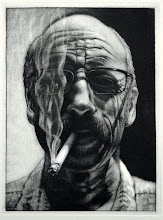What is solar plate?: It's a light sensitized steel backed polymer material, that is exposed with U.V light such as the sun (solar, get it?) and developed with tap water.
How is it done?: You can work directly on the plate with opaque materials in the form of non-water based pigments, or by exposing the plate through transparent film with artwork on it. The film may be created by drawing on acetate, photocopying or scanning and printing on film, or darkroom and/or photoshop techniques. A positive transparency is for printing an intaglio, a negative transparency is for printing a relief.
What etches the plate?: Water dissolves the unexposed portions of the plate. Either in large bold areas or tonal ranges.
The artwork is prepared with a variety of materials, such as opaque liquids, drawing devices such as lithographic pencils and crayons, spray paint, etc. It can be created by hand drawing, computer printout, of photographic methods. Non-water based materials if working directly on the plate. The images are created on transparent acetate or mylar. That transparency is used as a contact positive or negative.
The exposure has been set on the light table or exposure unit in the back of the studio for 20 seconds on the aquatint screen and 35 seconds on the transparency. Even though the plates can be exposed by sunlight, exposure units are preferred my most artists. The repeatable U.V. exposure offers consistency and reliability. The aquatint screen provides an continuous tone to the surface of the plate, while the transparency that contains the art work provides the image. The two together will create an image with full tonal or value range. With solar plate you have to expose the aquatint screen not only for tonal range, but also for additional hardening in the open areas.
The creation of an image on translucent or semi transparent film are considered positive images. If, as Rob suggests, you use a digital positive instead of a hand drawn image, you can skip the screen, but you may end up with some "foul biting" unless you play with the positive some. If you use a digital positive, 'curve' the tones in photoshop so the darkest tone is no greater than 70% black and print it on your transparency as a random dot bitmap.
Rob will print the plate on Wednesday and we'll recap further once someone is ready to expose!

No comments:
Post a Comment